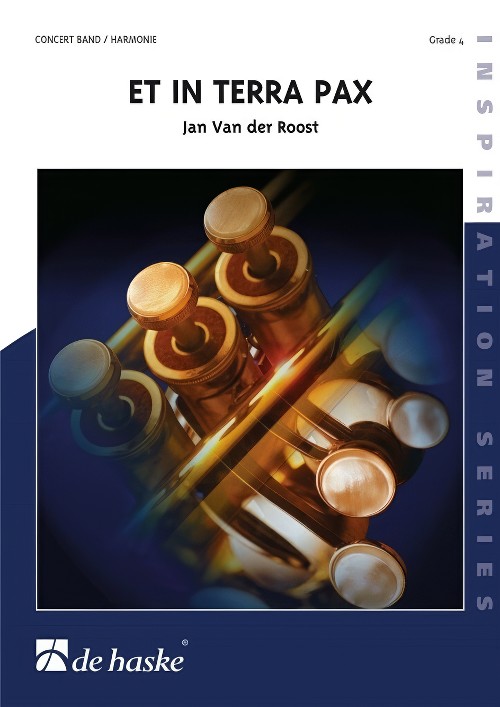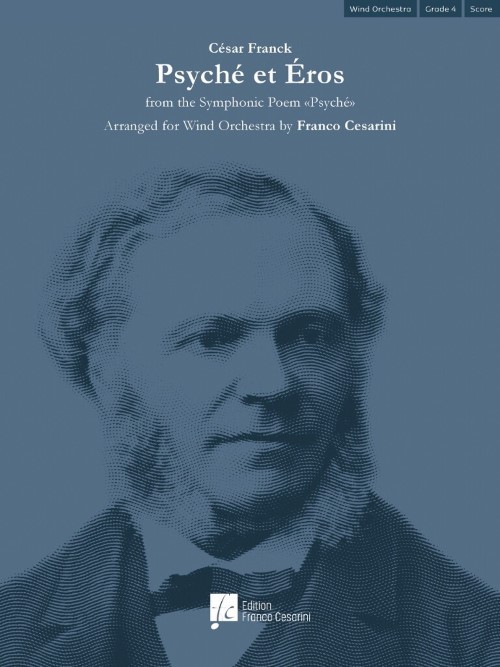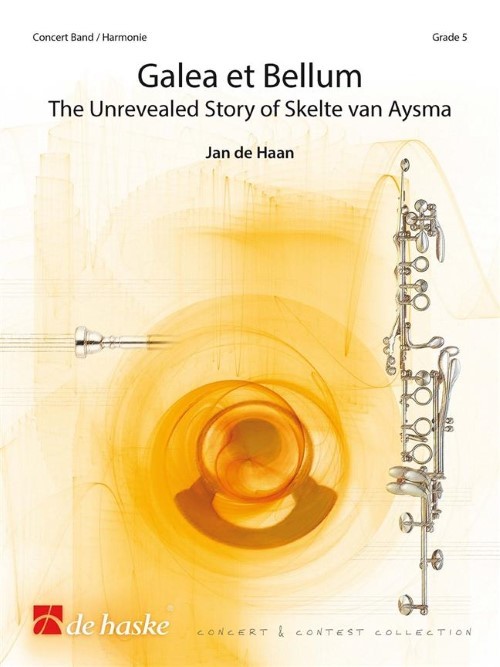Results
-
 £174.99
£174.99Et in terra Pax (Concert Band - Score and Parts) - Van der Roost, Jan
This piece was commissioned by the Concert Band Vlamertinge and is a plea for peace: the title translates as Peace on Earth. This is expressed by means of the vocal contribution expected from the performers. In various places of the piece you can recognize, the words Et In Terra Pax, an appeal for peace, at first jumbled together but later more rhythmically structured, developing into synchronized massed voices. The work starts with a pentatonic theme based on the notes D, E, G, A and C (taken from 'ConCErtbAnD VlAmErtinGE' and the name of the conductor, NiCk VAnDEnDriessChe). A somewhat sad melody is developed during an orchestral climax which leads to the first explosion of sound (measure 62 onwards). Suddenly the opening measures are recaptured, albeit with a differently coloured sound: the words Et in Terra Pax bring the first movement to a close. A restless Allegro follows which abruptly stops and is replaced by a calming chorale-like passage. A narrator reads aloud the poem 'Sonnet' by the young poet Charles Hamilton Sorley, who was killed during World War I. This poem fittingly puts into words the cruelty and senselessness of war. After the expanded recapitulation of the allegro, the broad, almost infinite atmosphere of the beginning returns. Clarinet and English horn play the pentatonic opening theme once more, this time broadly, while the words Et in Terra Pax are repeated again and again by the rest of the ensemble. The composer has purposely avoided all forms of aggression and bombastic sounds regularly used in works about war. Fear of violence and destruction can be heard and felt during the allegro passages. The charged opening makes way in the end for hope: May peacefulness replace cruelty in everyday life, too.Duration: 13:45
Estimated dispatch 7-14 working days
-
 £174.99
£174.99Et in terra Pax - Jan van der Roost
This piece was commissioned by the 'Concert Band Vlamertinge' and is a plea for peace: the title translates as 'Peace on Earth'. This is expressed by means of the vocal contribution expected from the performers. In various places of the piece you can recognize, the words 'Et In Terra Pax' - an appeal for peace - at first jumbled together but later more rhythmically structured, developing into synchronized massed voices.The work starts with a pentatonic theme based on the notes D, E, G, A and C (taken from 'ConCErtbAnD VlAmErtinGE' and the name of the conductor, NiCk VAnDEnDriessChe). A somewhat sad melody is developed during an orchestral climax which leads to the firstexplosion of sound (measure 62 onwards). Suddenly the opening measures are recaptured, albeit with a differently colored sound: the words 'Et In Terra Pax' bring the first movement to a close. A restless Allegro follows which abruptly stops and is replaced by a calming cho-rale-like passage. A narrator reads aloud the poem 'Sonnet' by the young poet Charles Hamilton Sorley, who was killed during World War I. This poem fittingly puts into words the cruelty and senselessness of war. After the expanded recapitulation of the allegro, the broad, almost infinite atmosphere of the beginning returns. Clarinet and English horn play the pentatonic opening theme once more, this time broadly, while the words 'Et In Terra... Pax' are repeated again and again by the rest of the orchestra.The composer has purposely avoided all forms of aggression and bombastic sounds regularly used in works about war. Fear of violence and destruction can be heard and felt during the allegro passages. The charged opening makes way in the end for hope: May peacefulness replace cruelty in everyday life, too.
Estimated dispatch 7-14 working days
-
£117.00
Marche et cortge (CB) - Charles Gounod - Bert Van Thienen
Marche et cortge from the opera La Reine de Saba (Queen of Sheba) by Charles Gounod (1818-1893).
Estimated dispatch 7-14 working days
-
 £143.00
£143.00Psyche et Eros (Concert Band - Score and Parts) - Franck, Cesar - Cesarini, Franco
Cesar Franck, composer, pianist, organist and music teacher, completed Cupid and Psyche, his sixth and last symphonic poem in 1887. It was first performed in Paris in 1888 and was a complete success, but the piece later fell completely into oblivion, and it was only thanks to some meticulous research that it has returned to concert halls. The intricate love affair between Psyche and Cupid is an original story of the Metamorphoses, written in the 2nd century AD by Apuleius. The tale is about overcoming obstacles in love and their final union. The symphonic poem is divided into three parts and calls for a choir. The movement that is the subject of this arrangement, Psyche et Eros, is positioned at the end of the second part. Franco Cesarini's version for wind orchestra carefully illustrates the nuances of the instrumental colours, and represents a real test aimed at demonstrating the musicality and interpretative skills of orchestras and their conductors. Duration: 10.30
Estimated dispatch 7-14 working days
-
 £209.99
£209.99Galea et Bellum (Concert Band - Score and Parts) - De Haan, Jan
The Unrevealed Story of Skelte van Aysma. Galea et Bellum was commissioned by the Excelsior Schraard music society (Friesland, the Netherlands). The work tells the story of a rare helmet that was discovered in a church in the Frisian village of Schettens in 2015. It uses the hymn Ah, how fleeting, ah how insignificant as a leitmotif.Duration: 15.00
Estimated dispatch 7-14 working days
-
 £104.99
£104.99Cort?'ge, Choral et Farandole Wind Band Set (Score & Parts)
Cort?ge, Choral et Farandole is a piece that any band, regardless of its level, will enjoy performing. Special attention has been paid to the choice of its tonality, to its register and to its orchestration to make it accessible. The work has three movements: Cortege - solemn in character and expressive through its majestic pace and tone, Choral - more serene and Farandole - a lively movement overflowing with cheerfulness and rejoicing. 0:06:00
Estimated dispatch 7-14 working days
-
 £143.00
£143.00Psych et ros - César Franck
Csar Franck, composer, pianist, organist and music teacher, completed Cupid and Psych, his sixth and last symphonic poem in 1887. It was first performed in Paris in 1888 and was a complete success, but the piece later fell completely into oblivion, and it was only thanks to some meticulous research that it has returned to concert halls. The intricate love affair between Psyche and Cupid is an original story of the Metamorphoseswritten in the 2nd century AD by Apuleius. The tale is about overcoming obstacles in love and their final union. The symphonic poem is divided into three parts and calls for a choir. The movement that is the subject of this arrangement, Psych et rosis positioned at the end of the second part.Franco Cesarini's version for wind orchestra carefully illustrates the nuances of the instrumental colours, and represents a real test aimed at demonstrating the musicality and interpretative skills of orchestras and their conductors.
Estimated dispatch 7-14 working days
-
 £209.99
£209.99Galea et Bellum - Jan de Haan
'Galea et Bellum' was commissioned by the Excelsior Schraard music society (Friesland, the Netherlands). The work tells the story of a rare helmet that was discovered in a church in the Frisian village of Schettens in 2015. It uses the hymn 'Ah, how fleeting, ah how insignificant' as a leitmotif.
Estimated dispatch 7-14 working days
-
£104.99
Cortge, Choral et Farandole - Roland Kernen
Cortge, Choral et Farandole is a piece that any band, regardless of its level, will enjoy performing. Special attention has been paid to the choice of its tonality, to its register and to its orchestration to make it accessible. The work has three movements: Cortege - solemn in character and expressive through its majestic pace and tone, Choral - more serene and Farandole - a lively movement overflowing with cheerfulness and rejoicing.
Estimated dispatch 7-14 working days
-
 £48.90
£48.90Chantons et Buvons, Tambours et Clairons - Roger Coiteux
Estimated dispatch 7-14 working days
